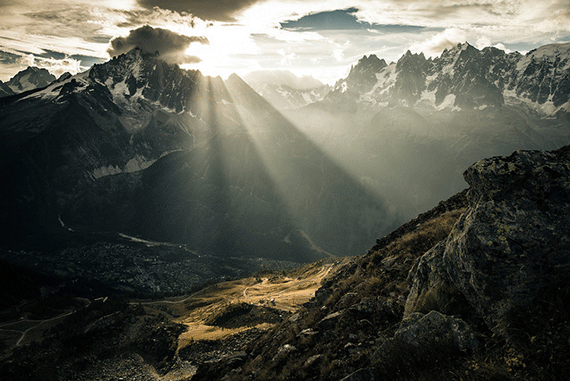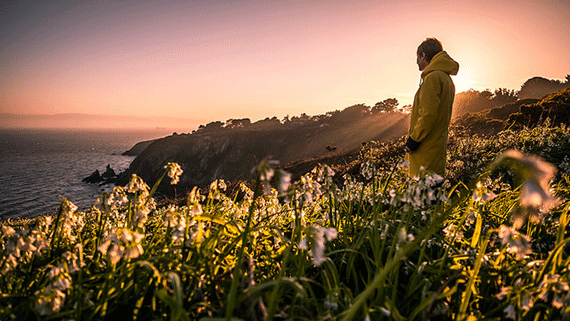It’s true that one cannot learn art, and you cannot induce in someone the eye for beauty. But if you have it in you, it can be honed to perfection.

Photo by Didier Baertschiger; ISO 200, f/14.0, 1/100-second exposure.
As a self taught landscape photographer who has learned everything from the hours of waiting for the perfect light to the mistakes committed, I feel both glad and proud to share the secrets and insights of landscape photography that contribute to the making of a great photograph. This is for all those who breathe through their lenses like me!
But before telling you the few basic ingredients to perfect landscape photography, let me tell you one secret that holds true even for the universe. It’s called the harmony. The key to every great thing is to strike the harmony right, and landscape photography is not an exception. Open your eyes to the harmony all around you!
Three P’s: Preparation, Patience and Perseverance
To capture the mystical and scintillating beauty of nature, you’ll have to wait at her doorstep, respecting her tantrums, whims, and fancies. After all, something that is so great or so beautiful is not readily available. And for all who think, landscape photography is easy, here’s where you’ll find out that it’s not. Behind an excellent photograph, there are days of research, hours of thoughts, weeks of getting to know the topography, angles, crowds, etc., endless failures, and months of sleepless eyes eager to catch the perfect moment.
To get something great, you need to have perseverance, patience, and also a lot of preparation. As a landscape photographer, I can guarantee that a great shot takes a lot of time and a whole lot of mental preparation. So, my first advice to you is to look around the geography before looking through your lens.
Scout your chosen area. Note its important features. Note the unusual and interesting angles and changing crowd levels. Take time to prepare the shot and make sure you’re ready with your tripod or mini-tripod, clean lenses, and the cable release before the best time of the day. Try out different filters and wait for a good foreground. If you have people in your frame, talk it out with them and break the ice to make them feel comfortable.
Choose a simple and clear layout
Too many subjects dilute the depth and focus of your photograph. Remember that what you call as a good shot is the one that focuses your attention on the subject by using a fairly sparse background and a simple and interesting composition to strike a clear harmony. Removing the clutter in your picture requires real skill. Achieve that. Landscape photography comes out best when you focus on your subject.

Photo by Ádám Tomkó; ISO 200, f/7.1, 1/1000-second exposure.
Not just landscape photography, any picture you click, requires that subtle judgment of de-cluttering your picture. For example, if you’re capturing a musician, try zooming in, getting close to your subject’s eye level, and finding a simple backdrop for your subject which will highlight your subject. Look for that vivid balance.
Play with colors
Look for bold solid colors for that unforgettable photograph. For vivid and warm landscape photography, notice stock-quality images; they make great use of color. So, while you are taking such a photograph, search for solid primary colors. Bright red, emerald green, lightning yellow, and ocean blue—solid colors give a different dimension to your picture. Use a polarizer to bring out the vivid colors. While you are playing with colors try to avoid patterns as much as possible, as they tend to distract your viewers from the subject.
Alternatively, for a calmer effect on your landscape photography, look for color harmony. Scenes restricted to similar tones and colors—or even a single color—bring out a calm, restful image where the eye plays with the differing shades and intensities. Look for pastels, creams, or delicate shades, when it’s a serene effect you want to capture.
Create drama with lights
In my specialty, which is landscape photography, I’ve often seen that photographs that win competitions are often the ones that make fascinating use of light. Keep an eye out for that silver lining— the beams of light shining through clouds, sparkling light through the trees or windows, elaborate long shadows and the effect of side and backlighting. Try to use the beautiful warm golden hours of early morning and late afternoon. You will experience magic through your lens at these hours. Maybe this is why they’re called ‘magic hours’. Landscape photography requires the skill of the use of light.
Of the people, for the people by the people
Include the power of people in your photographs. You must have noticed that magazines in particular always create a dramatic effect by including people in the shot. A human face or figure gives the viewer a human connection. It instills in your viewer a sense of being there, a sense of scale.

Photo by Giuseppe Milo; ISO 400, f/2.8, 1/4700-second exposure.
If you want to portray emotions there is nothing better than capturing a face to say it all. Laughter, despair, hope, hopelessness, proud, age—a human face tells it all. Simplify the shot down to one person for that exclusive reaction.
Catch the promise of tomorrow with the young and the worldly and the weather worn. Young and old faces make wonderful subjects with their innocent expressions and aged with wisdom faces respectively. They make your shots warm, friendly, and relatable. Like a good old friend. Such photographs never grow old.
Take heed of the above ingredients and mix them in an equal proportion according to your subject, place, and time, and you’ll see that in no time you have a photograph that you can be proud of!
About the Author:
A spontaneous dreamer and a soulful photographer of those dreams etched by nature, by passion and profession, I am Yaroslav Staniec (www.beautylandscape.co.uk), a dream catcher born in Poland and residing in England. It gives me much pleasure to master the art of capturing beauty if not time, through my lenses. Never fading colors, timeless black and whites and life like contours—witness the abundance nature has unfurled.
Like This Article?
Don't Miss The Next One!
Join over 100,000 photographers of all experience levels who receive our free photography tips and articles to stay current:






Excellent “to the point” summary – many thanks. And for landscape photographers, be prepared to repeatedly get up before dawn only to find days of disappointment when the environment fails. Perhaps the fourth P should be “Perturbed!”
Wow!! Awsome article. I loved the point you made about having “harmony” with nature. I’m a amateur nature photographer as well and I had to discovery this secret. Once I did, I noticed that the pics had so much more energy to them. Thank for those helpful tips as well. And like you said ,” After all, something that is so great or so beautiful is not readily available. And for all who thinks, landscape photography is easy, here’s where you’ll find out that it is not.” Very true statement. Thanks againg for your insight and sharing your knowledge.
Great article. I especially like the windmill photograph. Awesome composition, lighting and colors. Thank you!
These are some nice, solid tips. I’ll have to try these out next time I go shooting.
You said it right… In landscape, you will depend a lot on nature because it will be nature that is giving you the light!
Thank you for posting this! I have recently gotten started taking landscapes after being inspired by Peter Lik. If you have not heard of him check him out, his work is incredible! http://blog.peterlik.com/